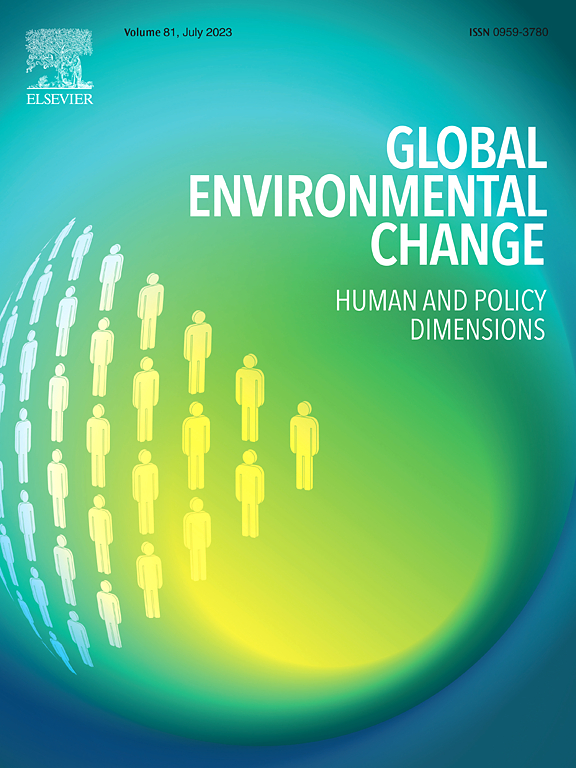Transformation in the context of uncertainty and compounding effects: Insights from marginal environments in India and Bangladesh
IF 9.1
1区 环境科学与生态学
Q1 ENVIRONMENTAL SCIENCES
引用次数: 0
Abstract
The TAPESTRY project explores how deliberate transformation may arise from 'below’ in marginal environments with high levels of uncertainty. TAPESTRY is short for ‘Transformation as Praxis: Exploring Socially Just and Transdisciplinary Pathways to Sustainability in Marginal Environments’. TAPESTRY focuses on three ‘patches of transformation’ in India and Bangladesh – vulnerable coastal areas of Mumbai, the Sundarbans and Kutch which are experiencing diverse uncertainties emanating from climate change as well as anthropogenic factors including neoliberal urban development, economic growth and aggressive infrastructure development. The project focused on existing and emergent transformative alliances and asked how we can seek and support socially just and ecologically sound alternatives based on local people’s plural understandings of what transformation entails. What kind of hybrid alliances are emerging to facilitate these transformative processes in these locations? And what are the possibilities for scaling up and out of the positive learnings from these patches?
A key conceptual innovation across all three patches was to think of transformation as praxis, by putting bottom-up change and the agency of marginalised people at the centre highlighting the practices and pathways of emergent changes and their barriers. In doing so, we address commonalities and differences across the three patches. A fragile coastline, shrinking and increasingly exploited mangrove forests, increasing exposure to climate hazards (such as cyclones, coastal erosion, flooding, sea level rise and extreme precipitation events), and diverse threats to marginal people’s livelihoods are the commonly observed factors. In terms of difference, we specifically focus on islanders in the transboundary Sundarbans forests (across the Bengal Delta in eastern India and Bangladesh), coastal fishing communities in the metropolitan region of Mumbai, and dryland pastoralists in Kutch in western India.
Using a transdisciplinary approach, a central focus is on exploring pathways to transformation through a bottom-up approach using participatory methods including stakeholder roundtables, photovoice, and mixed methods. Through local and regional collaborations, we attempted to co-produce hybrid knowledge combining Indigenous understandings of ecosystem changes and climate impacts with science-based scenarios. The aim was to restore resource-based livelihoods by showcasing local community perspectives in local-level environmental governance.
不确定性和复合效应背景下的转型:来自印度和孟加拉国边缘环境的见解
TAPESTRY项目探讨了在具有高度不确定性的边缘环境中,如何从“下面”产生深思熟虑的转变。TAPESTRY是“作为实践的转型:在边缘环境中探索社会公正和跨学科的可持续发展途径”的缩写。TAPESTRY专注于印度和孟加拉国的三个“转型补丁”——孟买、孙德尔本斯和库奇的脆弱沿海地区,这些地区正在经历各种不确定性,这些不确定性来自气候变化以及人为因素,包括新自由主义城市发展、经济增长和积极的基础设施发展。该项目侧重于现有的和新兴的变革联盟,并询问我们如何在当地人民对变革需要的多元理解的基础上寻求和支持社会公正和生态健全的替代方案。在这些地区,正在出现什么样的混合联盟来促进这些变革进程?从这些补丁中扩大和借鉴积极经验的可能性是什么?在这三个领域中,一个关键的概念创新是将转型视为实践,将自下而上的变革和边缘化人群的代理置于中心,突出了新兴变革的实践和途径及其障碍。在此过程中,我们解决了三个补丁之间的共性和差异。脆弱的海岸线、不断萎缩和日益被开发的红树林、日益暴露于气候灾害(如旋风、海岸侵蚀、洪水、海平面上升和极端降水事件)的风险,以及对边缘人群生计的各种威胁,都是常见的因素。就差异而言,我们特别关注跨界孙德尔本斯森林(横跨印度东部和孟加拉国的孟加拉三角洲)的岛民、孟买大都市区的沿海渔业社区和印度西部库奇的旱地牧民。采用跨学科方法,中心重点是通过自下而上的方法探索转型途径,使用参与式方法,包括利益相关者圆桌会议,photovoice和混合方法。通过地方和区域合作,我们试图共同生产混合知识,将土著对生态系统变化和气候影响的理解与基于科学的情景结合起来。其目的是通过展示地方社区对地方一级环境治理的看法,恢复以资源为基础的生计。
本文章由计算机程序翻译,如有差异,请以英文原文为准。
求助全文
约1分钟内获得全文
求助全文
来源期刊

Global Environmental Change
环境科学-环境科学
CiteScore
18.20
自引率
2.20%
发文量
146
审稿时长
12 months
期刊介绍:
Global Environmental Change is a prestigious international journal that publishes articles of high quality, both theoretically and empirically rigorous. The journal aims to contribute to the understanding of global environmental change from the perspectives of human and policy dimensions. Specifically, it considers global environmental change as the result of processes occurring at the local level, but with wide-ranging impacts on various spatial, temporal, and socio-political scales.
In terms of content, the journal seeks articles with a strong social science component. This includes research that examines the societal drivers and consequences of environmental change, as well as social and policy processes that aim to address these challenges. While the journal covers a broad range of topics, including biodiversity and ecosystem services, climate, coasts, food systems, land use and land cover, oceans, urban areas, and water resources, it also welcomes contributions that investigate the drivers, consequences, and management of other areas affected by environmental change.
Overall, Global Environmental Change encourages research that deepens our understanding of the complex interactions between human activities and the environment, with the goal of informing policy and decision-making.
 求助内容:
求助内容: 应助结果提醒方式:
应助结果提醒方式:


